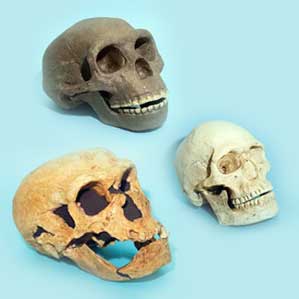 MIGUEL BOYAYANNot very long ago, the world was devoid of human beings. Around 200 thousand years ago – which is nothing compared to the 4.5 billion years of the Earth’s existence – continents were already in the position they are in now and most of the plant and animal species that now exist lived in practically untouched jungles and savannas. The first human beings with features similar to ours – legs longer than their backbone, flattened faces, and rounder and bigger skulls – inhabited a small region in Northeast Africa, in groups that probably did not add up to more than a few dozen or a couple of hundred individuals. This scene, described last century by archeologists and paleontologists, now includes recent attempts by genetic scientists and biologists to describe the past of humankind, and thus try to clarify how a small group of nearly hairless apes managed to multiply and spread around the world so successfully, to the point of influencing the destiny of the planet itself today.
MIGUEL BOYAYANNot very long ago, the world was devoid of human beings. Around 200 thousand years ago – which is nothing compared to the 4.5 billion years of the Earth’s existence – continents were already in the position they are in now and most of the plant and animal species that now exist lived in practically untouched jungles and savannas. The first human beings with features similar to ours – legs longer than their backbone, flattened faces, and rounder and bigger skulls – inhabited a small region in Northeast Africa, in groups that probably did not add up to more than a few dozen or a couple of hundred individuals. This scene, described last century by archeologists and paleontologists, now includes recent attempts by genetic scientists and biologists to describe the past of humankind, and thus try to clarify how a small group of nearly hairless apes managed to multiply and spread around the world so successfully, to the point of influencing the destiny of the planet itself today.
The effort to explain some of the man’s most basic doubts – where did our species come from and how did it become the way it is – always stirs up a heated debate, such as the one held in early November, at the First Biological Evolution Symposium in the city of Porto Alegre, State of Rio Grande do Sul. This meeting brought together some of the most outstanding genetics and evolution biology experts in the world. Yet it also became evident that the day in which we will have a single and conclusive answer to such apparently simple questions is still well into the future. There are many arguments to justify the results, which are often distinct and almost opposed, that researchers have come up with. Researchers have chosen different strategies to investigate mankind’s past, which is recorded in the genes of current populations.
A short summary of what paleontologists and archeologists discovered in the last century helps one to understand the current controversy. Bone fragments found in Herto and Omo Kibish in Ethiopia are the most persuasive evidence that Homo sapiens first appeared in Africa. One bone fragment is a skull estimated as 160 thousand years old, while another bone fragment is a 195-thousand year old skull. Fossils from other parts of the world also indicate that human beings as we know them remained in those regions for nearly 100 thousand years before taking their first steps out of Africa. Their first attempt in this respect did not take them very far, only to what is now the Middle East, as suggested by skeletons ranging from 120 thousand to 90 thousand years of age, found in Israel. Later on, between 70 thousand and 50 thousand years ago, another wave of humans from Africa apparently spread all over southern Asia, all the way to Australia. The third group leaving Africa went all the way to the middle and north of Asia and finally arrived in Europe, home of the stocky Homo Neanderthal, a humanoid species adapted to the cold climate and Homo sapiens’s closest kin. For reasons not yet understood, Homo Neanderthal disappeared gradually, some time after Homo sapiens arrived in Europe. This arrival coincides with Homo sapiens’s use of more refined techniques for making clothing, utensils and tools.
Everyone knows what happened next: Homo sapiens reached all the other continents and populated even the wildest regions of the planet, leaving his tracks wherever he went. It is much more complicated to retrieve the history of what happened in the past, during a period in which there are not enough fossil and archeological remains to explain in detail how the human species emerged and survived the extinction of the hominids. In the last two decades, the analysis of genetic characteristics shared or not by populations in different regions of the planet has provided clues that might help clarify doubts regarding modern man – did modern man appear between 200 thousand and 150 thousand years ago only in Africa, or did he exist in Asia as well? Did he eliminate other species of hominids, such as the Neanderthals, or did he live and procreate with them?
The most controversial view on how the human species evolved until it acquired its current characteristics and colonized the planet was presented in Porto Alegre by US biologist and statistician Alan Templeton, from the University of Washington in Saint Louis, Missouri. Templeton began his professional life as an expert in the genetics of heart diseases. About twenty years ago, he started studying human evolution, after having been invited by his friend Robert Sussman, publisher of the journal American Anthropologist, to write an article on the subject. Having analyzed everything that had been written on the topic, Templeton found serious methodological flaws in the articles that formed the basis of what is currently the most widely accepted theory on how the human species came into being what it is now – the so-called substitution hypothesis or the theory of the exit from Africa.
According to this theory, human beings left Africa between 60 thousand and 50 thousand years ago and spread into Asia and Europe, eliminating other hominid species along the way, such as Homo Neanderthal, a contemporary species. This theory is also referred to as the out-of-Africa theory; it became more popular after the 1987 publication, in Nature, of an article by biologists Rebecca Cann, Mark Stoneking and Allan Wilson. Using molecular genetics tools, they analyzed a specific type of genetic material – mitochondrial DNA, transmitted to descendants only through the mother – of 147 people from different regions around the world and concluded that the woman who was the forbear of part of contemporary human beings was an African who probably lived 150 thousand years ago; she became known around the world as the mitochondrial Eve.

eduardo cesarYesterday and today: Homo erectus, the ancestor of modern man (center) and the Neanderthal man (on the right), who may have been relatededuardo cesar
Templeton’s main criticism of this work is that when identifying the origin of modern man as being in Africa, the biologists assumed that this result justified the hypothesis of substitution. Thus, they excluded other possibilities – such as the simultaneous appearance of Homo sapiens, referred to as the multi-regional Homo sapiens, in Asia as well – and disregarded the most basic steps of the scientific method. In addition, the biologists did not conduct statistical tests that would allow for the elimination of other hypotheses. According to Templeton, by doing so, Rebecca, Stoneking and Wilson merely demonstrated that the out-of-Africa theory was compatible with the data, but they did not prove that the other models were incompatible.
Bothered by this arbitrary choice, Templeton, who had developed a form of genetic analysis that brings together groups according to genetic and geographic proximity, devised a way of trying to eliminate the models that were incompatible with generic data. The reasoning is simple: if after leaving Africa between 100 thousand and 50 thousand years ago Homo sapiens had eliminated other species without mating with them and leaving any offspring, the genetic material of current human beings would be exclusively of African origin. “If this were true, the genetic contribution of human populations from other continents would have been eliminated”, explains biologist Reinado Alves de Brito, from the Federal University of São Carlos, and a former doctoral student under Templeton.
This is not what was found. Analyzing 25 samples of genetic material of the current populations from different parts of the world, Templeton discovered that some of those samples had traces of ancestors who had lived in Asia during a period prior to 130 thousand years ago, before Homo sapiens had left Africa for the first time. Templeton wrote about this in several articles published in the last few years in Evolution. So what happened”
In Templeton’s opinion, the data show that colonization of other continents had begun far earlier, some 1.9 million years ago, when an ancestor of our species – the Homo erectus, which US biologist Jared Diamond classified as being more than an ape but less than a human being – left Africa to go to Asia. This first journey was possibly followed by two other journeys: one which took place about 650 thousand years ago and a more recent one about 130 thousand years ago. Each time these human ancestors, with increasingly less archaic characteristics, would leave Africa and would come across groups that had left earlier, they would mate with these groups and leave offspring. “When these groups met, they would make love and not war”, says Templeton, in whose opinion the Homo species is a continuous lineage that took on distinct characteristics little by little.
Many experts disagree with him. “From the theoretical point of view, it is possible that this mating actually occurred. But when evaluating the distribution of the fossils and the archeological records, it does not seem so believable”, says paleontologist and anthropologist Danilo Bernardo, from Human Evolution Studies Laboratory of the University of São Paulo/USP.
Swiss biologist Laurent Excoffier from the University of Berne is one of the researchers who totally disagree with Templeton. Excoffier devised a computer program, used worldwide, for the genetic analysis of populations. In Porto Alegre, Excoffier presented the findings of his latest research studies, conducted jointly with Nelson Fagundes and Sandro Bonatto, from the Pontifical Catholic University of Rio Grande do Sul. The study was published in October in the Proceedings of the National Academy of Sciences. In this study, the researchers sequenced 50 samples of genetic material extracted from 30 individuals from Africa, Asia and South America.
Using a method that they had developed, they calculated how each of these parts had changed over hundreds of thousands of years and tried to see which of the eight human evolution models best explained genetic differences among current populations. They concluded that it was probably the out-of-Africa model, rejected by Templeton. According to the researchers’ calculations, Homo sapiens probably appeared 140 thousand years ago and a group of 600 individuals might have left Africa 50 thousand years ago. “These findings agree with what most researchers believe actually happened”, says Bonatto.
How can such conflicting results be explained? In the opinion of the Brazilian researcher, Templeton based his reasoning on an erroneous assumption. Even if Homo sapiens had completely eliminated the other hominid species he found along the way without leaving any offspring, part of his genetic material would have to be very old, having been inherited from an African ancestral species. Templeton criticizes the fact that a sample of only 25 people had been analyzed by Excoffier and the Brazilian team. Templeton and Excoffier agree on at least one point. As more genetic information is collected from more people around the world, as is being collected by the Human Genome project, the findings will probably become more accurate and perhaps finally reveal who is right.
Republish
